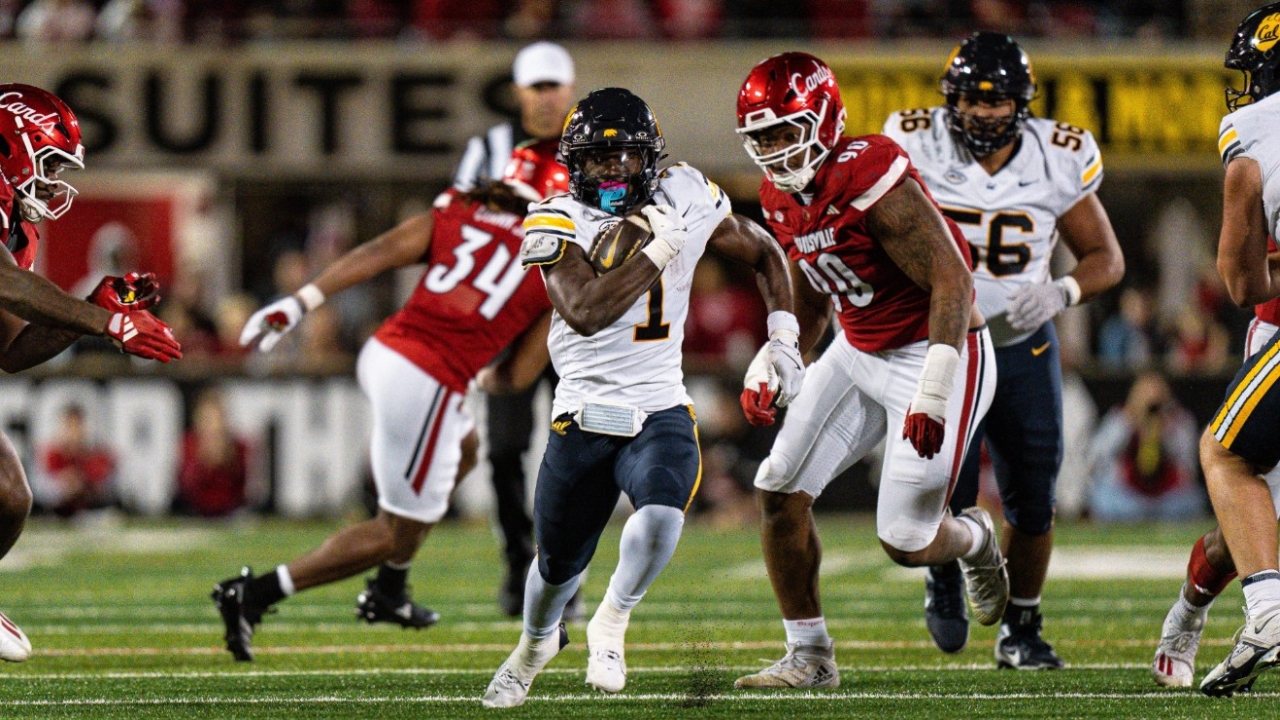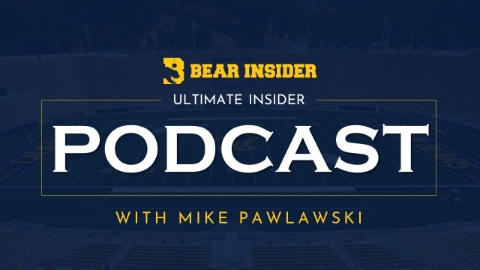Paws Analysis: Cal’s Statement Win at Louisville, the Mindset Behind It and What It Means

Bears fans—what a week.
Cal went into a hostile environment against the No. 15 Louisville Cardinals and walked out with a 29–26 overtime win. That’s not just a W in the standings; that’s a temperature check on the program’s resilience, identity, and ceiling heading into the stretch run. In a year that has tested this team—bad snaps, protection issues, missed chances—this was the performance the Bears needed: connected, tough, and composed when it mattered most.
I’ll get into the details, the mindset, and the film takeaways. I also sat down with head coach Justin Wilcox to talk about what changed, why it worked, and how it carries into Big Game week.
Circle the Wagons, Finish the Job
Road wins against ranked teams don’t come cheap. You earn them in the margins: composure, consistency, and execution on critical snaps. Louisville is a legit, physical team with skill dudes who stress you on both sides of the ball. Add in a loud crowd and a top-15 ranking, and the environment becomes a character test.
What stood out first: this Cal team has not fractured. Even in the frustrating moments earlier this season—think Virginia Tech—these guys didn’t splinter. They didn’t finger-point. They kept working. That matters. When you travel a day early, live together for 72 hours, and the stadium’s rocking against you, all that time invested in doing things right shows up. It showed up in Louisville.
The Offensive Line: Accountability, Adjustments, and a Step Forward
I’ve been blunt about the O-line this season because the truth is the truth: if your five up front don’t set the tone, nothing else matters. This week, Cal made significant personnel Boscia swung in and did the dirty work. Braden Miller and Nick Morrow took on big roles at tackle. It wasn’t flawless (it never is), but it was functional and connected. That extra beat for the QB? It changes everything.
Run game? Better. Part of that is opponent structure—Louisville plays downhill and aggressive—so if you crease them, you hit the second level fast. But a big piece was simply cleaner steps, fewer blown assignments, and the confidence that grows when things start on time. When the ball is snapped on target, protections can set, RPO windows exist, and the quarterback can read rotation without hunting for the ball. That one small variable reverberates through an entire offense.
JKS: Accuracy is a Superpower
I’ve said this all year: the number one trait for a quarterback is accuracy. (The late Mike Leach hammered that point for decades.) Jaren Sagapolutele delivered again: 30-for-47 (64%), 323 yards, 2 TDs—and some absolute darts layered into tight windows. The touchdown to Landon Morris? That’s a grown-man throw—anticipation, velocity, and no fear. Several balls to Jacob DeJesus were NFL-location throws: leverage, timing, and pace.
The common denominator: time. Give JKS a half-second more and his innate accuracy goes from “talented” to “tilting the field.” You saw it on over routes, seams, and rhythm throws that punish pressure. You also saw it late—OT winner, man-beater concept, on time and on target. That’s courage and craft in one snap.
Jacob DeJesus, Mismatch Machine
The book is out on Jacob: if you leave him static, a defense can travel a corner, press him, or bracket him from depth. Credit OC Bryan Harsin—he makes Jacob a moving target. Backfield, slot, boundary, motion—he stresses the rules. It forces defenses to declare and chase. The result: 16 catches (ties Cal’s single-game record) and the whip route that broke Louisville’s back in overtime.
What doesn’t show up on the stat sheet: DeJesus’ energy is infectious. He practices hot, plays hot, and lifts the room. He isn’t the tallest, but he’s strong, twitchy, and relentlessly competitive. That stuff is contagious.
Numbers That Tell the Story
Total offense: Cal 427 yards. It’s been a minute since we talked about output like that on the road against a ranked team.
Third down: Cal 44.4%. That’s winning football. It means you’re staying out of 3rd & forever and operating on schedule.
Defense on third down: Held Louisville to 35.3%. Bend when you must, bow up in the money downs.
Time of possession: Dead even (29:52 Cal / 30:08 Louisville). In a game that tight, each possession’s efficiency mattered.
Completion rate: Cal 63.3% vs. Louisville 51.3%. You want the higher number. It correlates with rhythm and red-zone opportunities.
QB rating: Cal 136.7 vs. Louisville 89.9. In the NFL, passer rating is an underrated winning indicator. This gap reflected the eye test: Cal’s QB outplayed theirs.
Add the Zeke Masses interception to open the second half—situational defense in the “middle eight” (last 4:00 of 2Q and first 4:00 of 3Q)—and you see the spine of a complete road win.
The Conversation with Coach Wilcox
Coach called it their “most complete game” so far—and he’s right. Was it perfect? No. But complementary football finally clicked. Here are the key levers he highlighted:
Snaps on target: It sounds simple, but it’s everything. With clean snaps, JKS’ eyes stayed downfield. The whole operation sped up in the right ways.
Pocket integrity: Not perfect, but better. Fewer inside-edge losses. More step-up lanes. Just enough time to unlock the deep overs and layered zone beaters.
Run game grit: Kendrick Raphael supplied tough yards at the exact right moments (especially in OT).
Red zone defense: Forced field goals. Against top offenses, “3 instead of 7” buys your offense chances later.
Corner play: Multiple one-on-one wins. When your scheme stresses corners, you need answers out there. They delivered.
Situational edge: Middle eight, third downs, and overtime execution. That’s coaching, prep, and poise.
On Louisville’s pressure packages, Coach said it clean: “They’ll keep bringing it until you make them pay.” Cal did—slants, perimeter answers, quick game, and then hitting shot plays once the rush softened and windows opened.
On the OT decision to go for it on 4th-and-3: it came down to trust in No. 3 (JKS) and No. 21 (DeJesus). You don’t make that call unless your quarterback is cooking and your wideout is winning leverage. They were—and Cal slammed the door.
Complimentary Shoutouts
Beyond DeJesus and JKS:
Landon Morris stepped up with Mason Mini dinged. That TD catch was big-time.
Cole Boscia earned reps the old-fashioned way—special teams, blocking, glue plays—then answered when his number was called.
Zeke Masses changed momentum with the pick and stacked it with solid coverage and improved tackling.
Paco Austin had critical PBUs.
A bunch of dudes played a lot of snaps who weren’t getting them in Week 1.
Coach gave out a small fortune in game balls because the win required a collective. That’s how road upsets happen.
The Mindset Shift: Don’t “Rise,” Replicate
Here’s a truth most people miss: you don’t “rise to the occasion” in this sport; you fall to the level of your training. When practice habits are tight and mental focus is repeatable, game day becomes replication—same footwork, same eyes, same tempo—under brighter lights. Cal took an important step in Louisville by playing who they practice to be.
That’s also why protecting a young QB matters beyond the stat sheet. Constant pressure speeds up his feet, shortens his vision, and introduces “phantom” rush the next week. Give him time and the game slows down. You saw that progression on Saturday.
Big Game Week: What Travels, What Matters
Now the focus shifts to The Big Game—trip to the Farm, likely wet grass, and all the pageantry that makes college football special. For players who just arrived via portal or are new to the rivalry, Coach and staff do a good job educating them on the history. You can’t fake four decades of memory in nine months, but you can internalize the standard: play your best football when it’s loud, emotional, and personal for your community.
From a football standpoint, here’s the scouting picture:
Stanford’s season profile: Scoring ~17.5 per game, allowing ~30. The yards differential and third-down rate (~37%) tell you they’ve struggled to sustain drives.
Turnover margin: –6. That often defines losing seasons.
Sacks: 18 for, 38 against. That’s a stress fracture up front.
Red zone: 87% scoring but only 47% TDs—too many field goals. Kicking game is typically strong (and is again this year).
QB picture: Veteran Ben Gulbranson has experience but will put balls in harm’s way. The young talent Brown can spin it and run, but inexperience shows up in reads and pacing.
True weapon: TE Sam Rausch is the real deal—NFL dude. He’ll be the best tight end Cal faces all year. Must have answers for him on third down and in the red zone.
WRs: Not elite as a group. The speed threat is there in flashes, but consistency isn’t.
Keys for Cal’s defense:
Stop the run, then make the quarterback beat you from the pocket. Win early downs so you can heat them on 3rd & long. Be disciplined with eyes on Rausch and tackle clean once the ball hits the perimeter.
Keys for Cal’s offense:
With the revamped O-line, lean into what worked at Louisville: clean snaps, identify pressure, and attack the secondary. Stanford plays plenty of man—create stacks, motion, and rubs; let JKS pick matchups and let DeJesus be a moving chess piece. If the Bears win the front on early downs, the vertical game opens—and JKS loves to push it.
This one always gets chippy. It should. But if Cal reproduces the operational cleanliness from Louisville—on-time snaps, sorted protections, efficient third downs—they’ll have the right blueprint.
Why Louisville Matters Beyond One Win
It wasn’t just the upset. It was the how:
Protect your quarterback and the entire playbook wakes up.
Defend situationally and field goals become hidden wins.
Trust your best players in the biggest moments.
And it was the who:
Veterans stepping up.
New starters believing they belong.
Role players becoming finishers.
That stack of behaviors isn’t a one-week phenomenon. It’s portable. Bring it to the Farm.
Final Whistle
Cal needed a pivot game. They got it in Louisville—overtime grit, star power at quarterback and receiver, a stabilizing step by the O-line, and a defense that squeezed in money spots. It wasn’t perfect, but football rarely is. It was enough—and it’s replicable.
Now it’s Big Game week. Educate the new guys on the history. Embrace the pageantry. Then do the mundane things with ruthless efficiency: snap it true, block it right, tackle with leverage, win the next play.
Do that, and the rest takes care of itself.
Listen in: I’ll be on the call with Justin Allegri (and Ben Ross on the sideline) on KSFO 810 AM. Pregame starts one hour before kickoff. We’ll also share the booth cam on my social channels—follow along on Facebook and LinkedIn for the live link and more Paws Plays of the Week breakdowns coming soon.
As always—Go Bears.


